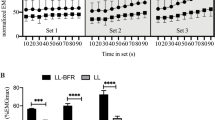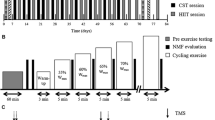Abstract
This study investigated the acute effects of NMES on blood lactate (BLa) and performance parameters in trained male triathletes. On three separate days, 13 trained male triathletes performed six 30 s Wingate tests (30 WanT) on a cycle ergometer. Each session consisted of performing 3 × 30 WanT (bouts 1–3) followed by a randomly assigned 30 min recovery intervention of either: (i) passive (seated), (ii) active (cycling at 30% VO2max) or (iii) NMES (1 Hz/500 μs-ON:OFF 2:6 s). The 3 × 30 WanT bouts were then repeated (bouts 4–6) and compared to bouts 1–3 for peak power (PP), mean power (MP) and fatigue index (FI). BLa and heart rate (HR) were recorded at designated time points throughout. Data were analyzed using repeated measures ANOVA with Tukey’s honestly significant difference post hoc test. BLa decreased significantly faster during the active recovery intervention (P < 0.001), however, there were no significant differences between interventions for PP (P = 0.217), MP (P = 0.477) and FI (P = 0.234) when the post intervention bouts (4–6) where compared to the pre intervention bouts (1–3). NMES during recovery was not more effective than active or passive recovery for improving subsequent performance. Despite BLa clearing at a significantly faster rate for the active recovery intervention, PP, MP or FI did not improve significantly compared to NMES and passive. In conclusion, NMES does not appear to be more effective than traditional methods for enhancing short-term recovery from supra-maximal exercise bouts in trained male triathletes.





Similar content being viewed by others
References
Ahmaidi S, Granier P, Taoutaou Z, Mercier J, Dubouchaud H, Prefaut C (1996) Effects of active recovery on plasma lactate and anaerobic power following repeated intensive exercise. Med Sci Sports Exerc 28:450–456
Ament W, Verkerke GJ (2009) Exercise and fatigue. Sports Med 39:389–422
Astorino TA, Roberson DW (2010) Efficacy of acute caffeine ingestion for short-term high-intensity exercise performance: a systematic review. J Strength Cond Res 24:257–265
Bailey DM, Erith SJ, Griffin PJ, Dowson A, Brewer DS, Gant N, Williams C (2007) Influence of cold-water immersion on indices of muscle damage following prolonged intermittent shuttle running. J Sports Sci 25:1163–1170
Barfield JP, Sells PD, Rowe DA, Hannigan-Downs K (2002) Practice effect of the Wingate anaerobic test. J Strength Cond Res 16:472–473
Barnett A (2006) Using recovery modalities between training sessions in elite athletes: does it help? Sports Med 36:781–796
Billaut F, Bishop D (2009) Muscle fatigue in males and females during multiple-sprint exercise. Sports Med 39:257–278
Bogdanis GC, Nevill ME, Lakomy HK, Graham CM, Louis G (1996) Effects of active recovery on power output during repeated maximal sprint cycling. Eur J Appl Physiol Occup Physiol 74:461–469
Carrasco L, Sanudo B, de Hoyo M, Pradas F, Da Silva ME (2011) Effectiveness of low-frequency vibration recovery method on blood lactate removal, muscle contractile properties and on time to exhaustion during cycling at VO(2max) power output. Eur J Appl Physiol (Epub ahead of print)
Connolly DAJ, Brennan KM, Lauzon CD (2003) Effects of active versus passive recovery on power output during repeated bouts of short term, high intensity exercise. J Sports Sci Med 2:47–51
Cortis C, Tessitore A, D’Artibale E, Meeusen R, Capranica L (2010) Effects of post-exercise recovery interventions on physiological, psychological, and performance parameters. Int J Sports Med 31:327–335
Cortis C, Tessitore A, Perroni F, Lupo C, Pesce C, Ammendolia A, Capranica L (2009) Interlimb coordination, strength, and power in soccer players across the lifespan. J Strength Cond Res 23:2458–2466
Crisafulli A, Orru V, Melis F, Tocco F, Concu A (2003) Hemodynamics during active and passive recovery from a single bout of supramaximal exercise. Eur J Appl Physiol 89:209–216
Dupont G, Blondel N, Berthoin S (2003) Performance for short intermittent runs: active recovery vs. passive recovery. Eur J Appl Physiol 89:548–554
Dupont G, Moalla W, Guinhouya C, Ahmaidi S, Berthoin S (2004) Passive versus active recovery during high-intensity intermittent exercises. Med Sci Sports Exerc 36:302–308
Franchini E, Yuri Takito M, Yuzo Nakamura F, Ayumi Matsushigue K, Peduti Dal’Molin Kiss MA (2003) Effects of recovery type after a judo combat on blood lactate removal and on performance in an intermittent anaerobic task. J Sports Med Phys Fitness 43:424–431
Gill ND, Beaven CM, Cook C (2006) Effectiveness of post-match recovery strategies in rugby players. Br J Sports Med 40:260–263
Heyman E, de Geus B, Mertens I, Meeusen R (2009) Effects of four recovery methods on repeated maximal rock climbing performance. Med Sci Sports Exerc 41:1303–1310
Higgins TR, Heazlewood IT, Climstein M (2011) A random control trial of contrast baths and ice baths for recovery during competition in U/20 Rugby union. J Strength Cond Res 25:1046–1051
Howatson G, Gaze D, van Someren KA (2005) The efficacy of ice massage in the treatment of exercise-induced muscle damage. Scand J Med Sci Sports 15:416–422
Jackson AS, Pollock ML (1978) Generalised equations for predicting body density of men. Br J Nutr 40:497–504
Kohler RM, Rundell KW, Evans TM, Levine AM (2010) Peak power during repeated wingate trials: implications for testing. J Strength Cond Res 24:370–374
Lattier G, Millet GY, Martin A, Martin V (2004) Fatigue and recovery after high-intensity exercise. Part II: Recovery interventions. Int J Sports Med 25:509–515
Lau S, Berg K, Latin RW, Noble J (2001) Comparison of active and passive recovery of blood lactate and subsequent performance of repeated work bouts in ice hockey players. J Strength Cond Res 15:367–371
Leal Junior EC, Lopes-Martins RA, Frigo L, De Marchi T, Rossi RP, de Godoi V, Tomazoni SS, Silva DP, Basso M, Filho PL, de Valls Corsetti F, Iversen VV, Bjordal JM (2010) Effects of low-level laser therapy (LLLT) in the development of exercise-induced skeletal muscle fatigue and changes in biochemical markers related to postexercise recovery. J Orthop Sports Phys Ther 40:524–532
MacIntosh BR, Rishaug P, Svedahl K (2003) Assessment of peak power and short-term work capacity. Eur J Appl Physiol 88:572–579
Maffiuletti NA (2010) Physiological and methodological considerations for the use of neuromuscular electrical stimulation. Eur J Appl Physiol 110:223–234
Maffiuletti NA, Bendahan D (2009) Mesurement methods of muscle fatigue. In: Williams C, Ratel S (eds) Human muscle fatigue. Routledge, Oxon, p 25
Maffiuletti NA, Cardinale M (2010) Alternative modalities of strength and conditioning: electrical stimulation and vibration. In: Cardinale M, Newton R, Nosaka K (eds) Strength and conditioning: biological principles and practical applications. Wiley-Blackwell, Oxford, pp 193–196
Martin V, Millet GY, Lattier G, Perrod L (2004) Effects of recovery modes after knee extensor muscles eccentric contractions. Med Sci Sports Exerc 36:1907–1915
McLoughlin TJ, Snyder AR, Brolinson PG, Pizza FX (2004) Sensory level electrical muscle stimulation: effect on markers of muscle injury. Br J Sports Med 38:725–729
Neric FB, Beam WC, Brown LE, Wiersma LD (2009) Comparison of swim recovery and muscle stimulation on lactate removal after sprint swimming. J Strength Cond Res 23:2560–2567
Philp A, Macdonald AL, Watt PW (2005) Lactate—a signal coordinating cell and systemic function. J Exp Biol 208:4561–4575
Pournot H, Bieuzen F, Duffield R, Lepretre PM, Cozzolino C, Hausswirth C (2010) Short term effects of various water immersions on recovery from exhaustive intermittent exercise. Eur J Appl Physiol (Epub ahead of print)
Robertson A, Watt JM, Galloway SD (2004) Effects of leg massage on recovery from high intensity cycling exercise. Br J Sports Med 38:173–176
Sayers MG, Calder AM, Sanders JG (2011) Effect of whole-body contrast water therapy on recovery from intense exercise of short duration. Eur J Sports Sci 11:293–302
Sear JA, Hoare TK, Scanlan AT, Abt GA, Dascombe BJ (2010) The effects of whole-body compression garments on prolonged high-intensity intermittent exercise. J Strength Cond Res 24:1901–1910
Souissi N, Bessot N, Chamari K, Gauthier A, Sesboue B, Davenne D (2007) Effect of time of day on aerobic contribution to the 30-s Wingate test performance. Chronobiol Int 24:739–748
Spencer M, Bishop D, Dawson B, Goodman C, Duffield R (2006) Metabolism and performance in repeated cycle sprints: active versus passive recovery. Med Sci Sports Exerc 38:1492–1499
Spencer M, Dawson B, Goodman C, Dascombe B, Bishop D (2008) Performance and metabolism in repeated sprint exercise: effect of recovery intensity. Eur J Appl Physiol 103:545–552
Spierer DK, Goldsmith R, Baran DA, Hryniewicz K, Katz SD (2004) Effects of active vs. passive recovery on work performed during serial supramaximal exercise tests. Int J Sports Med 25:109–114
Tessitore A, Meeusen R, Cortis C, Capranica L (2007) Effects of different recovery interventions on anaerobic performances following preseason soccer training. J Strength Cond Res 21:745–750
Tessitore A, Meeusen R, Pagano R, Benvenuti C, Tiberi M, Capranica L (2008) Effectiveness of active versus passive recovery strategies after futsal games. J Strength Cond Res 22:1402–1412
Thiriet P, Gozal D, Wouassi D, Oumarou T, Gelas H, Lacour JR (1993) The effect of various recovery modalities on subsequent performance, in consecutive supramaximal exercise. J Sports Med Phys Fitness 33:118–129
Toubekis AG, Adam GV, Douda HT, Antoniou PD, Douroundos II, Tokmakidis SP (2010) Repeated sprint swimming performance after low- or high-intensity active and passive recoveries. J Strength Cond Res 25:109–116
Watt KK, Hopkins WG, Snow RJ (2002) Reliability of performance in repeated sprint cycling tests. J Sci Med Sport 5:354–361
Weber MD, Servedio FJ, Woodall WR (1994) The effects of three modalities on delayed onset muscle soreness. J Orthop Sports Phys Ther 20:236–242
Williams C, Ratel S (eds) (2009) Human muscle fatigue. Routledge, Oxon
Acknowledgments
The authors gratefully acknowledge the funding supplied by Bio Medical Research Ltd., Galway, Ireland and Enterprise Ireland to enable the study to be completed.
Conflict of interest
Funding for this study was partially supported by Bio Medical Research (BMR) Ltd., Galway, Ireland. BMR is the manufacturer of the NMES device used in this study.
Author information
Authors and Affiliations
Corresponding author
Additional information
Communicated by William J. Kraemer.
Rights and permissions
About this article
Cite this article
Malone, J.K., Coughlan, G.F., Crowe, L. et al. The physiological effects of low-intensity neuromuscular electrical stimulation (NMES) on short-term recovery from supra-maximal exercise bouts in male triathletes. Eur J Appl Physiol 112, 2421–2432 (2012). https://doi.org/10.1007/s00421-011-2212-9
Received:
Accepted:
Published:
Issue Date:
DOI: https://doi.org/10.1007/s00421-011-2212-9




